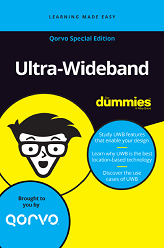Empowering the Next Generation with Ultra-Wideband: A University’s Hands-On Innovation Journey
November 4, 2025
At the Institut Universitaire de Technologie (IUT) in Blagnac, France, a quiet revolution in ultra-wideband (UWB) education and research is underway. Thanks to a long-standing collaboration with Qorvo, faculty and students are developing real-world applications that bridge the gap between innovation, education and industry.
What began with a challenge in a PhD research project, accurately localizing nodes that kept getting nudged out of place, has grown into a robust, multi-facility UWB test bed. The project, spearheaded by IUT Blagnac’s educators and researchers Carine Livoti, Adrien Vonenbosch and Réjane Dalcet, is part high-tech experimentation, part professional training platform, and entirely driven by passion for accessible innovation.
“Our platform was built opportunistically,” said Adrien. “It wasn’t directly funded at the beginning, but every time we had a project, we looked for ways to expand and improve the platform.” With Qorvo’s early support and technology access, the team was able to get hands-on with UWB modules before the broader market recognized their potential. “This gave us a real head start,” he added.
The test bed spans two main locations: a research facility and a “smart home” environment in Blagnac. In the research building, UWB nodes are deployed in open spaces and even inside anechoic chambers to simulate radio-isolated conditions. Some nodes are installed on rails to allow for controlled movement, and recent additions include robotic mobility to add a higher degree of experimentation.
But it’s the smart home installation that reveals the human-centered possibilities of UWB. “It’s about more than experiments,” said Réjane. “It’s about providing a service to people, testing how UWB can function in real environments, with real users.” From locating lost keys to optimizing hospital asset management, their UWB applications focus on transforming technical localization data into intuitive, human-readable outputs. Instead of cryptic coordinates, systems can say, “Your keys are next to the coffee maker in the kitchen.”

The team also places an emphasis on education and training. Their platform supports both undergraduate students and professionals from engineering schools and industry. As Carine noted, “At first, students may tune out when we explain that UWB occupies at least 500 megahertz of spectrum. But once they participate in hands-on activities, like a treasure hunt app built on UWB, the technology becomes real and exciting.”
That spirit of engagement drives the team’s larger mission: to popularize UWB and make cutting-edge research accessible to startups, educators and professionals. “A few years ago, I had never even heard of ultra-wideband,” said Carine. “Now, thanks to Qorvo, we are working with startups and developing training sessions that help people outside of academia understand and apply this technology.”

Qorvo’s contribution has gone far beyond supplying hardware. Their partnership has helped IUT Blagnac create an educational and experimental environment that merges technical rigor with public-facing impact. It’s a model for how industry and academia can collaborate to make complex technology both approachable and transformative.
Looking ahead, the Blagnac team sees even more opportunities to grow. They are working on turning UWB data into natural-language feedback for use in healthcare, smart homes and public services. Their goal is to continue opening research to the world and bringing innovation from the lab to everyday life. As Réjane put it: “We want to make ultra-wideband popular, understandable and useful. Not just for researchers, but for everyone.”
Find out more about Qorvo UWB solutions here.
Have another topic that you would like Qorvo experts to cover? Email your suggestions to the Qorvo Blog team and it could be featured in an upcoming post. Please include your contact information in the body of the email.
